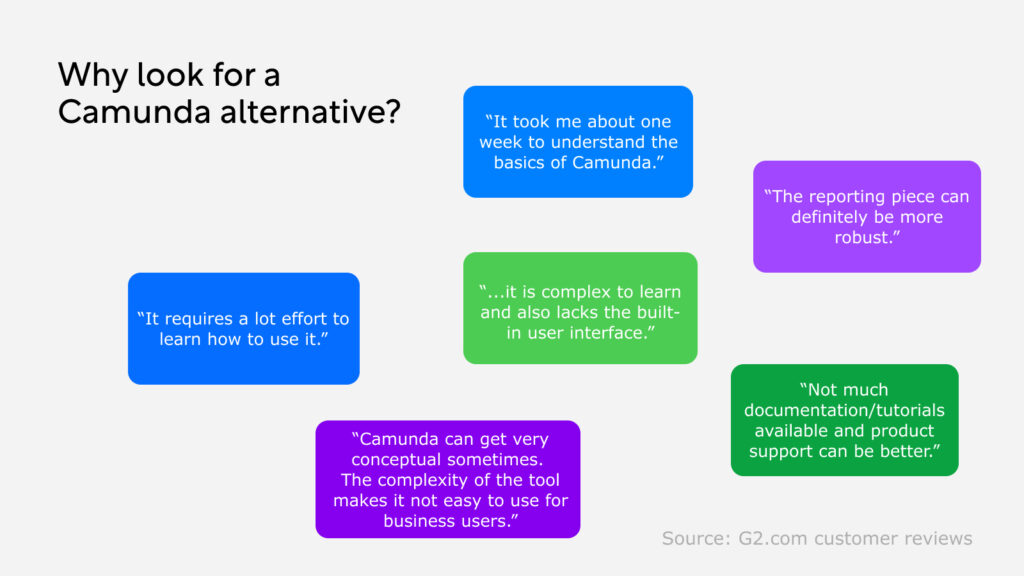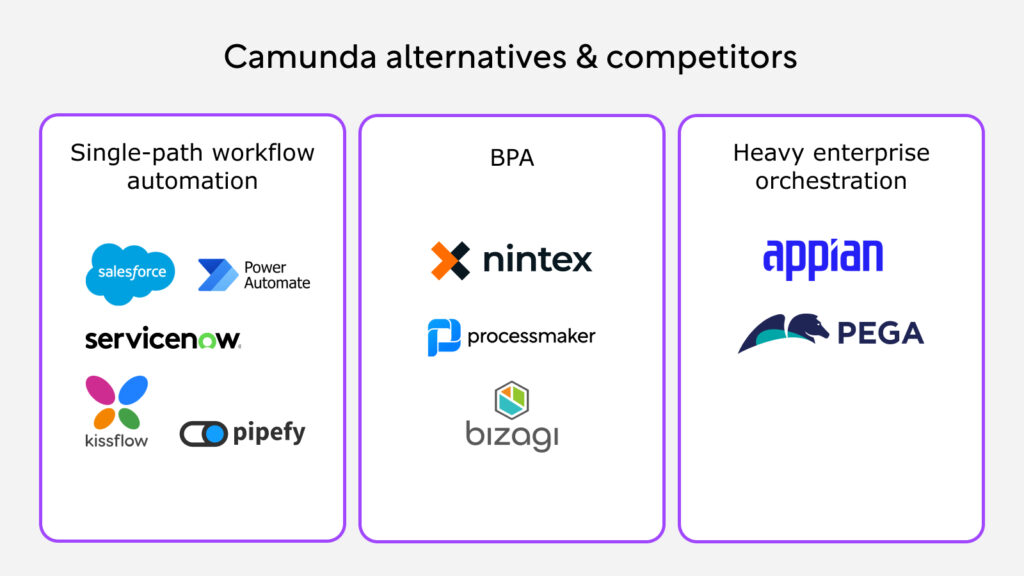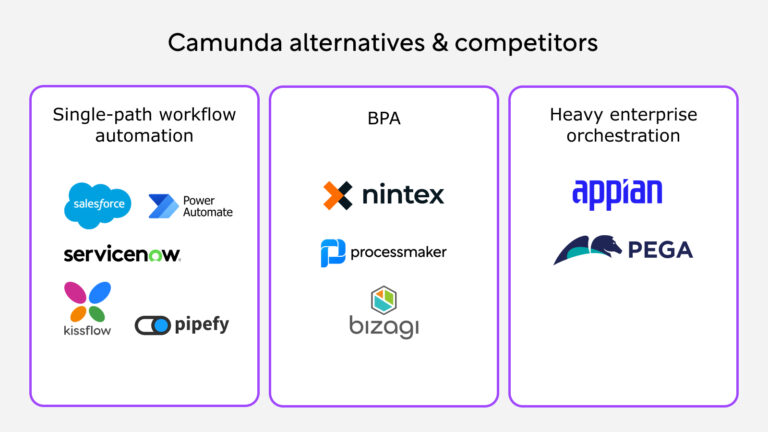Camunda has established itself as an end-to-end process orchestration platform. Coming at $100M annual recurring revenue, it has solidified its position in the market as one of the leading process automation platforms.
However, this is not the only available alternative in the market, and there are many other tools and platforms that can help you in your process automation journey depending on your organization’s needs. But how do you choose the right one? You can find all the answers in this guide.
Is Camunda right for your business?
Camunda is a software suite that helps businesses automate their end-to-end processes across systems, devices, and people. The platform is known for its open-source foundation and focus on complex process orchestration.
Camunda strongly adheres to the Business Process Model and Notation (BPMN) standard for process modeling. This ensures interoperability and makes it easier for developers to understand and work with Camunda processes.
Key features of Camunda
- BPMN compliance
Camunda emphasizes using the BPMN standard for modeling processes. The platform supports importing and exporting BPMN models, ensuring interoperability with other BPMN-compliant tools.
- Orchestration capabilities
Camunda’s strength lies in orchestrating processes, spanning multiple systems, ensuring visibility into execution. This makes it suitable for organizations with more complex automation needs.
- Developer-Centric Approach
Camunda distinguishes itself by focusing on developers and prioritizing technical capabilities. Its scripting and custom code development enables developers to create highly customized solutions and plugins to extend the platform’s functionality.
Why look for a Camunda alternative?
While Camunda is a great process orchestration tool, it’s never a one-size-fits-all in the software world. Different companies have unique challenges that may make Camunda not the ideal fit for their automation needs. Some common challenges and limitations mentioned by Camunda users are the following:

- Complexity of user interface
The sources consistently point out that Camunda’s user interface is not as user-friendly or intuitive as some competitors. The software users have mentioned that it’s too complex to use and requires a lot of time and effort to master.
- Limited native-AI features
Camunda relies heavily on integrations with external AI services for tasks like process optimization, form design, and insights. While Camunda does have a process and form design assistant, it relies on integrating with external AI services while some competitors have an in-app AI agent.
- Scalability challenges
Camunda’s focus on complex orchestration might make it less suitable for simpler workflow automation tasks. Moreover, the deployments across different departments with varying technical expertise may get complex since the software is harder to use for less technical people.
- Limited business user tools
Camunda’s complexity is especially challenging for non-technical users, potentially hindering adoption in organizations lacking developer resources or those seeking a more approachable low-code/no-code experience. Camunda offers less design control for process owners and business users than alternatives.
Our top Camunda alternatives List:

1. ProcessMaker BPA platform
ProcessMaker is an end-to-end business process automation platform whose design and development tools offer the fastest time-to-value for even the most complex automation needs.
Compared to Camunda, it offers a more balanced platform suitable for a wider range of users with intuitive low-code features and competitive pricing. ProcessMaker is suitable for non-technical users as well, allowing them to easily build and automate workflows, which is not the case for Camunda as it heavily relies on scripting languages.
Apart from workflow automation capabilities, ProcessMaker offers an extensive process intelligence (PI) suite that provides visibility and transparency over even the most complex business processes. Thanks to the prioritized automation recommendations offered by PI, companies know exactly what to automate. Moreover, it helps to further evaluate the effectiveness of implemented automation initiatives and focus on projects that bring the highest ROI.
Key features of ProcessMaker:
- Ease of use and user-friendliness
ProcessMaker’s intuitive low-code/no-code environment allows for faster and easier deployment, while its user-friendly AI-enabled interface makes it accessible even for business users with little to no technical background.
- Comprehensive process intelligence
ProcessMaker provides superior process and task mining capabilities, process discovery, and improvement insights. Its Process Intelligence tool gives a 180° transparency, leaving no processes in shadow.
- Native AI capabilities
ProcessMaker uses Agentic AI technology like FlowGenie to understand user requests and perform actions within the platform, such as generating process models, designing forms, or answering queries.
- Process mapping
ProcessMaker’s drag-and-drop process mapping interface provides total control for any user to build BPMN process models. From the same place, the process model can be immediately turned into a usable workflow with forms, decisions, automation, integrated AI, and more.
- Process orchestration
ProcessMaker connects people, processes, and systems through in-app interfaces and APIs, allowing organizations to go beyond simple workflows and manage entire functions in one place.
Who is it for?
ProcessMaker aims to provide business process automation and orchestration solutions for organizations with a wide range of automation maturity levels, from simple workflows to complex orchestration. Compared to other alternatives, ProcessMaker offers a lower barrier to entry – both in pricing and ease of building.
The platform caters to a wider range of users. This includes both professional developers and citizen developers looking for tools that make development faster; business leaders and process owners who want to optimize thier teams, as well as IT managers who need to easily scale automation.
2. Appian
Appian is a business process automation (BPA) platform that specializes in delivering enterprise-grade applications for complex orchestration. Compared to other automation tools, Appian focuses on serving large enterprises with complex automation needs and leans towards professional developers for building and deploying applications.
Compared to Camunda and ProcessMaker, a higher level of technical expertise is required to utilize the platform fully. Although Appian tends to be on the higher end of the pricing spectrum, it offers free access to the Appian Community and the free version of the platform for customers to use the software before making a big investment decision.
Key features of Appian:
- Low-code development
Appian’s platform emphasizes a visual, low-code development environment that simplifies the process of building and deploying applications. This allows developers to focus on the business logic rather than the underlying code, potentially speeding up development cycles.
- High technical capability
Since Appian’s focus is on enterprises with complex process architecture, the software offers advanced features for building and deploying sophisticated processes.
- Pre-built connectors
Appian offers pre-built connectors for well-known applications, though they also rely on partners to fill out the marketplace offering.
Who is it for?
Appian is best suited for large enterprises with complex automation needs that require heavy orchestration capabilities. Its target audience primarily includes professional developers responsible for building and deploying enterprise-grade applications.
Organizations with a high volume of document-heavy processes can benefit from Appian’s integrated IDP capabilities, further streamlining operations and improving data accuracy.
3. Pega systems
Pega is a Business Process Automation (BPA) platform, specializing in delivering solutions for complex orchestration and case management.
It offers a comprehensive suite of tools encompassing low-code development, workflow orchestration, and robotic process automation (RPA). Similar to Appian, Pega primarily targets large enterprises with complex, heavy processes and a strong need for case management capabilities.
The software is able to handle heavy process loads, but it has a steep learning curve and requires extensive training for users in return.
Key features of Pega systems:
- Case management
Pega excels in case management, providing tools to handle complex, unstructured processes that require dynamic adaptation and collaboration. Its case management framework allows users to track case progress, manage related documents, and collaborate effectively to resolve issues.
- Low-code development
Pega offers a low-code development environment, which significantly speeds up development cycles.
- Pega Blueprint
This AI feature provides templates and guidelines for outlining processes and jumpstarting development, particularly for specific departments or functions.
Who is it for?
Pega Systems is best suited for large enterprises with complex, mission-critical business processes that demand sophisticated orchestration and case management. Its strength lies in handling intricate workflows and automating tasks across multiple systems; thus, it’s not optimal for simple workflows. Pega’s solutions are typically implemented by professional developers and require specialized expertise due to their complexity and the need for customization.
4. Bizagi
Bizagi is a Business Process Automation (BPA) platform designed to help organizations model, automate, and optimize their business processes. It offers a suite of tools to support the entire process lifecycle.
Compared to Pega, Appian, and Camunda, Bizagi’s key strength lies in its user-friendly process modeling capabilities and its focus on enabling business users to participate in the automation journey.
Key features of Bizagi:
- Bizagi modeler
This tool allows users to visually design and map business processes using the BPMN standard. It’s easy to use and is free for individuals. The modeler software is available separately from the automation studio.
- Bizagi studio
This is Bizagi’s development environment where process models are converted into executable processes. Bizagi Studio offers a low-code interface, making it easier to build and configure process logic, user interfaces, and integrations with other systems.
- Integrations
Bizagi offers pre-built connectors for popular enterprise applications like SAP, Salesforce, and Microsoft Dynamics. It also supports custom integrations using APIs.
Who is it for?
Bizagi is well-suited for organizations of various sizes that want to empower business users to actively participate in process automation. Its intuitive process modeling tool and low-code development environment make it accessible to a broader range of users compared to more technically-focused platforms like Camunda.
5. Nintex
Nintex offers two different Business Process Automation (BPA) platforms that enable a broad range of users to automate workflows and processes. The two platforms offer a suite of tools to cover various automation needs, including workflow design, document generation, RPA, and e-signatures. Platforms with different capabilities are available for cloud- or self-hosing.
Like ProcessMaker and Bizagi, Nintex is known for its user-friendly approach, catering to both business users with limited technical expertise and IT professionals seeking robust customization options.
Key features of Nintex:
- Process mapping and design
Nintex offers visual process modeling tools to help users map and design workflows intuitively. It currently supports importing and exporting BPMN models and offers a process modeler emphasizing detailed documentation.
- Robotic process automation (RPA)
Nintex offers RPA capabilities integrated with its platform. It allows users to automate repetitive tasks using software bots, going beyond core workflow functionalities.
- Document generation and management
Nintex offers features for creating templates, merging data into documents, and automating document workflows, simplifying document-heavy processes.
Who is it for?
Nintex targets organizations wanting to empower a wide range of users with automation capabilities and those deeply integrated with the Microsoft ecosystem. While it may not be an ideal platform for highly complex enterprise-grade processes, its ease of use makes it easier to adopt automation across the organization.
6. Salesforce
Primarily known for its leading Customer Relationship Management (CRM) platform, Salesforce offers substantial business process automation capabilities through Salesforce Flow.
While not solely focused on BPA like Camunda, Salesforce’s BPA capabilities are embedded within its CRM platform, aiming to automate and streamline business processes primarily related to customer interactions and sales operations.
Key features of Salesforce:
- Business rules engine
Salesforce allows users to implement decision logic and automate rule-based actions through a Business Rules Engine for managing business rules.
- Focus on customer interactions
Salesforce Flow excels in automating processes related to customer interactions, sales operations, and marketing functions.
- Closeness with the Salesforce ecosystem
Salesforce Flow is integrated within the larger CRM platform, making it easy to integrate with other tools and features within the Salesforce ecosystem.
Who is it for?
Salesforce’s BPA capabilities are best suited for organizations seeking to automate processes tightly integrated with their CRM system and customer-facing operations. Flow may not be the best option for wider organization-wide complex use cases.
Organizations already utilizing Salesforce CRM can extend their capabilities to automate workflows and processes directly within their existing environment. Salesforce Flow’s native integration with various Salesforce Clouds and the AppExchange marketplace simplifies development and deployment.
7. ServiceNow
ServiceNow offers BPA capabilities through its Now Platform. While not solely dedicated to general-purpose BPA like Camunda, ServiceNow utilizes its robust IT service management (ITSM foundation) and vast ecosystem to deliver automation solutions.
Key features of ServiceNow:
- Workflow automation
The Now Platform enables users to build automated workflows using tools like Flow Designer and Process Automation Designer, which allows both simpler and more complex process modeling and automation.
- AI-powered features
ServiceNow uses AI and machine learning to enhance its BPA capabilities for tasks such as recommending content, generating code from text prompts, and assisting with process modeling.
Who is it for?
ServiceNow’s BPA capabilities are particularly well-suited for organizations seeking to automate processes within their IT service management operations and extend that automation to encompass broader business functions.
Its tight integration with core IT modules and the availability of pre-built applications for specific IT processes simplify development and deployment, leveraging existing expertise within the ServiceNow environment.
8. Pipefy
Pipefy is a cloud-based business process automation platform that enables businesses to easily create and automate workflows. It offers an intuitive, visual interface for building workflows, known as “pipes,” and provides a range of features to support process management, including task management, reporting, and integrations.
Key features of Pipefy:
- Visual workflow builder
Pipefy offers a user-friendly, drag-and-drop interface for building workflows, enabling users to create and automate processes without the need to code.
- Forms and data collection
Users can create custom forms to collect data associated with processes and automate actions based on the information collected.
- Task management
Pipefy provides tools to manage tasks, assign responsibilities, set deadlines, and track progress within workflows.
Who is it for?
Compared to other tools like Camunda, ProcessMaker, and Bizagi, Pipefy is more effective for simpler linear workflows. Thanks to its intuitive design and integrations, it can be a great tool for even business users with no coding experience. However, this is not the best platform for end-to-end process orchestration of complex parallel workflows spanning different teams and departments.
9. Kissflow
Kissflow is a cloud-based, low-code work platform that offers a suite of tools for workflow and process automation, case management, and project management. Its focus is on empowering business users to build and manage their own solutions with minimal reliance on IT, promoting agility and faster time to value. Kissflow’s primary focus is on simple workflow automation and case management use cases.
Key features of Kissflow:
- Visual workflow designer
Kissflow offers a user-friendly, drag-and-drop interface for building and automating workflows without coding, making it accessible to business users.
- Form builder
The platform enables users to create custom forms for data collection and manage data within the platform, supporting structured workflows and processes.
- Project management and collaboration
Kissflow includes project management capabilities, enabling teams to plan, manage, and track projects within the same platform, offering a unified workspace.
Who is it for?
Kissflow is mainly for businesses seeking a user-friendly, low-code platform for automating simple linear workflows and managing cases. Kissflow’s focus on ease of use and minimal reliance on IT can lead to faster implementation and deployment of solutions compared to more developer-centric platforms like Camunda.
Kissflow may not be suitable for highly complex orchestration, but it caters to business users and citizen developers, aiming to empower them to build and manage solutions with minimal coding or technical expertise.
10. Microsoft Power Automate
Microsoft Power Automate is a cloud-based BPA platform. Tightly integrated within the Microsoft ecosystem, Power Automate offers a low-code approach to automation, making it accessible to both business users and developers. Power Automate is available only as SaaS.
Key features of MS Power Automate:
- Microsoft ecosystem
Power Automate is deeply embedded within the Microsoft ecosystem, offering seamless integration with a wide range of Microsoft products and services. This makes it a natural choice for organizations heavily invested in the Microsoft stack.
- Workflow designer
Power Automate offers a user-friendly, drag-and-drop interface for designing simple workflows.
- Process and task mining
Power Automate includes process mining and task mining features to analyze existing processes, identify bottlenecks, and discover automation opportunities.
Who is it for?
Power Automate is best for organizations deeply embedded in the Microsoft ecosystem. Its low-code development environment and visual designer make it easier for users with limited coding experience.
Conclusion
The business process automation landscape offers a plethora of options, with Camunda emerging as one of the strong players. However, selecting the right vendor depends on your organization’s specific needs. Whether you’re seeking a platform for simple workflows or complex orchestration, tailored for business users or developers, or suitable for long-term projects or occasional automation tasks, these factors will guide your decision.
Options vary in development environment, integrations, AI capabilities, process optimization, and interface. With careful consideration, you’ll find the perfect fit—and Camunda is just one of many possibilities.
Check out other comparison articles:
Top 10 Appian Competitors and Alternatives
Top 10 Bizagi Competitors and Alternatives





